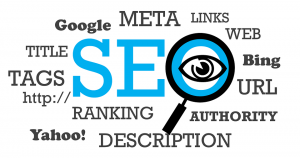Search Engine Optimization (SEO) focuses on making sure people who are looking for your goods and services online will find and explore your website. This primarily works though Search Engines such as Google, Bing and Yahoo.
This is basically a match-making process. An individual interested in good X types in certain search terms into Google. Google then selects websites that fit best to these search terms, ranks them, and presents them to the person requesting the information. This is where SEO comes to play.
Through SEO techniques, an advertiser can increase the probability of Google and other search engines finding a website, matching it to the search term(s), and ranking it in a specific order.
One way of doing this is through the placement of appropriate search terms/keywords on your website. The first step is to identify vital search terms potential clients are using to look for your product. Are they looking for “footwear”, “shoes”, or “Sneakers”? Do they add certain attributes such as “affordable”, “trendy”, or “for women”? It makes sense to select only the best search terms to ensure a good fit and prevent mismatches. Nobody likes to be directed to a website about flip-flops if you are specifically looking for classy dress shoes for a banquet. By the way, Google’s Keyword tool can help you find variations and estimate the average number of searches per month. This input will also help you with your paid search advertisements, which is a separate element of Search Engine Marketing (SEM).
The next step is placing these search terms strategically on your website. Here is where the structure of your website comes to play. It makes sense to create certain sub-sections that house corresponding search terms so Search Engines can easily recognize these terms. This structure depends on the good and services you are providing. Some firms might want to separate goods and services by brands, others by colors, and again others by price or special features – there is no “one size fits all” approach. These individualized pages should include pictures and links to useful internal web pages or even external ones. Getting visitors to interact with your page will greatly help you compete as it signals to the Search Engine that the content is indeed a good match – why else would someone continue browsing a webpage. Writing blogs about certain topics using these search terms will also help increase visibility and keep clients updated at the same time. Consider inserting a comment section to provide the option to give feedback and initiate a conversation.
If your website is relatively new and hasn’t experienced much traffic, you can increase your visibility by encouraging other websites/people to share your website. Google recognizes if a highly respected website directs people to yours by embedding your URL. You will basically profit from their good performance and reputation. This is probably the trickiest technique, but a great opportunity to become truly creative.
Last but not least: don’t stop improving! Use your Google Analytics data to refine your search term/keyword list and page structure. Experiment and find new creative ways of attracting paying customers who you might not even have considered, yet.


